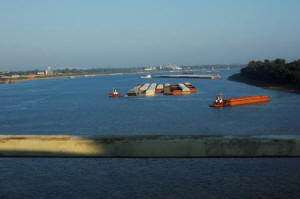|
Wooden dams and river jams: U.S. strains
to ship record grains
 Send a link to a friend
Send a link to a friend
 [December 05, 2017]
By Tom Polansek and Karl Plume [December 05, 2017]
By Tom Polansek and Karl Plume
ABOARD THE OLIVER C. SHEARER, Ohio River
(Reuters) - America's worst traffic jam this fall occurred on the Ohio
River, where a line of about 50 miles of boats hauling grains and other
products turned into a waterborne parking lot, as ship captains waited
for the river to reopen.
Such delays are worsening on the nation's waterways, which are critical
to commerce for the United States, the largest grain exporter in the
world. Of the country's $40 billion in annual grain and soybean exports,
about 60 percent is moved by barges on rivers, including the Ohio.
The shutdown, caused by worn or missing sections of a dam, snarled
traffic from early September into early November through Locks & Dam No.
52 near Paducah, Kentucky. It was the second shutdown in two months at
No. 52, which is among the country's busiest locks with about $22
billion a year of commodities flowing through it.
The lock, which has been earmarked for replacement by the Army Corps of
Engineers for three decades, is one of many choke points along 25,000
miles of waterways used to transport everything from grains to consumer
goods to coal. (Graphic: http://tmsnrt.rs/2AY9sim)

It is a system increasingly under strain. Surging shipments of soybeans
and corn - due to record harvests - are overwhelming parts of the
antiquated network and causing more frequent and severe backups,
according to interviews with farmers, shippers, grains merchants and
barge operators.
Reverberations have cut across the U.S. agricultural supply chain - and
international markets. This fall, delays in moving crops downriver
bumped up grain prices at export terminals along the Gulf Coast, opening
up an advantage for global competitors such as Brazil.
Most of the country's 239 locks have exceeded their half-century design
lives, and nearly half the vessels that use the nation's inland
waterways now experience delays, according to the American Society of
Civil Engineers.
The average delay per lock has nearly doubled on the waterways since the
beginning of the century, rising to 121 minutes in 2014 from 64 minutes
in 2000, the group said.
An October National Waterways Foundation study said a major lock failure
in the Midwest could cost shippers $1.5 billion per year in added costs
and overwhelm existing rail and road capacity. Every barge can hold as
much grain as 16 rail cars or 70 trucks.
SWOLLEN STOCKS
The delays here and elsewhere are boosting prices for key goods
including soybeans, and eating away at the nation's competitive edge
against rival exporters like Brazil.
U.S. soybean export prices normally drop in the autumn, as newly
harvested supplies flood the market. But the delays caused prices to
rise, making it harder for the United States, the second-largest soybean
exporter, to compete with Brazil, which ranks first.
In mid-August, the price of soybeans loaded for export at U.S. Gulf
Coast terminals was about $14 per metric ton below the cost of soybeans
loaded at Brazil's Paranagua port, according to industry data. By
mid-November, the U.S. advantage had been cut to less than $4 per ton.
Brazil's soybeans have a higher protein content, and therefore attract a
premium.

Top soy importer China is expected to buy twice as many soybeans from
Brazil in the fourth quarter as it did last year, much of it at the
expense of U.S. shipments. [nL4N1N731I]
Export markets are key for farmers and grain processors due to rising
crop yields. In the past two decades, U.S. corn output has outpaced
domestic use by 20 percent, and soybeans by more than 70 percent.
"Being near the river used to be an advantage, but now having to wait on
dams and infrastructure is more of a liability to farmers," said Marc
Bremer, a farmer in Metropolis, Illinois.
Bremer sells most of his corn and soybeans to facilities known as
elevators, which receive and store grain and load barges on the Ohio
River. This autumn, he lost up to $30,000 in revenue when prices tumbled
because disruptions caused crop stockpiles to swell at these facilities.
He said he may delay buying new farm equipment as a result.
[to top of second column] |

Towboats and barges wait during lock delays at Locks 52 and 53 on
the Ohio River in Cairo, Illinois, U.S., September 20, 2017.
According to the U.S. Army Corps of Engineers, modernization of the
facilities at Locks and Dam 52 and Locks and Dam 53 were authorized
under the provisions of the Rivers and Harbors Act of March 3, 1909,
but the original structure of 52 was completed in 1928 and 53’s
original structure was completed in 1929. Photograph taken at
N36°59.683' W89°08.696'. Photo taken September 20, 2017.
REUTERS/Brian Snyder

The log jams hit local grain buyers - the elevators - who cut bids
on crops to the lowest levels since the Port of New Orleans was
shuttered by Hurricane Katrina in 2005.
Elevators, including those owned by Bunge Ltd, Cargill Inc and
Archer Daniels Midland Co, typically fill barges with corn and
soybeans en route to the Gulf of Mexico. But the backup meant they
were unable to ship out supplies - overwhelming their storage, too.
'HIDDEN COST'
Along the river in Shawneetown, Illinois, Bunge piled soybeans
outside on the ground, putting them at risk of damage from rain or
animals, because the elevator's bins were full due to the backlog,
local farmers said. An employee of Bunge's elevator said it took
this step because of "market conditions."
Randy Anderson, a farmer from Galatia, Illinois, said he was told to
hold back pre-arranged deliveries of crops to the Bunge elevator.
Instead, he was forced to take time away from harvesting to load the
crops into his own storage bins.
"That could have been time I could have been in the field," he said.
"That's a hidden cost."
The effect was also felt by shipping companies, which make more
money the more trips their barges make. Barge operator Campbell
Transportation Company of Pittsburgh estimated a loss of $1 million
in revenue in September and October because of the delays.
"This was the difference between a small profit and a big loss,"
said Peter Stephaich, Campbell chief executive.

Replacing Locks and Dam No. 52 and nearby No. 53 on the Ohio River
has been on the U.S. Army Corps of Engineers' to-do list for about
thirty years, even as its backlog of other projects has grown.
Known as the Olmsted Locks and Dam, the replacement is set to
finally be completed next year. Its cost has risen to about $3
billion from an original estimate of $775 million.
In the meantime, the short-term work to fix the dam continues.
Divers working in pitch-black water needed a week to repair the
largest hole in the 90-year old dam, one of the last on the river
made of wooden slats. Repairs to three other worn and corroded
sections may be completed this month.
For the seven-man crew of the Oliver C. Shearer, one of 70 towboats
hauling hundreds of barges carrying goods, the delay at Locks & Dam
No. 52 meant killing time. But there was only so much paperwork,
repairs, or waxing the checkerboard floor of the vessel that the
crew could do.
"You start beating your head against the wall," Michael McCloud, the
boat's captain, said in October as he looked out at idle barges on
the Ohio River from the vessel's bridge.
(For more on life along the Ohio River, see [nL1N1O000E]. For a
photo essay, see http://reut.rs/2BF3xM8)
(Reporting by Karl Plume in Chicago and Tom Polansek on the Oliver
C. Shearer and in Paducah, Kentucky; Editing by David Gaffen and
Paul Thomasch)
[© 2017 Thomson Reuters. All rights
reserved.]
Copyright 2017 Reuters. All rights reserved. This material may not be published,
broadcast, rewritten or redistributed.
 |